The Effect of Different Biochar on the Mechanical Properties of Cement-Pastes and Mortars
Abstract
:1. Introduction
2. Materials and Methods
2.1. Materials
2.2. Biochar Characterization
2.3. Samples Preparation
2.4. Mechanical Tests
3. Results
3.1. Biochar Characterization
3.1.1. Water Absorption
3.1.2. Particle Size Distribution
3.1.3. Brunauer-Emmett-Teller Analysis (BET)
3.1.4. FESEM
3.1.5. Thermogravimetric Analysis (TGA)
3.2. Mechanical Test Results
4. Discussion
5. Conclusions
Author Contributions
Funding
Data Availability Statement
Conflicts of Interest
References
- United Nations. Department of Economic and Social Affairs, Revision of World Population Prospects. 2022. Available online: https://population.un.org/wpp/ (accessed on 18 November 2022).
- Nwakaire, C.M.; Yap, S.P.; Onn, C.C.; Yuen, C.W.; Ibrahim, H.A. Utilisation of recycled concrete aggregates for sustainable highway pavement applications; a review. Constr. Build. Mater. 2019, 235, 117444. [Google Scholar] [CrossRef]
- International Energy Agency (IEA). Global Energy Review: CO2 Emissions in 2021; IEA: Paris, France, 2021. [Google Scholar]
- Nasir, M.H.A.; Genovese, A.; Acquaye, A.A.; Koh, S.; Yamoah, F. Comparing linear and circular supply chains: A case study from the construction industry. Int. J. Prod. Econ. 2017, 183, 443–457. [Google Scholar] [CrossRef]
- GHabert, G.; Miller, S.A.; John, V.M.; Provis, J.L.; Favier, A.; Horvath, A.; Scrivener, K.L. Environmental impacts and decarbonization strategies in the cement and concrete industries. Nat. Rev. Earth Environ. 2020, 1, 559–573. [Google Scholar] [CrossRef]
- OECD. Global Material Resources Outlook to 2060; OECD: Paris, France, 2019. [Google Scholar] [CrossRef]
- Gustavsson, J.; Cederberg, C.; Sonesson, U. Global Food Losses and Food Waste: Extent, Causes and Prevention; Study Conducted for the International Congress Save Food! At Interpack 2011, [16–17 May], Düsseldorf, Germany; Food and Agriculture Organization of the United Nations: Rome, Italy, 2011. [Google Scholar]
- Bergeron, F.C. Energy and climate impact assessment of waste wood recovery in Switzerland. Biomass-Bioenergy 2016, 94, 245–257. [Google Scholar] [CrossRef]
- Lopatina, A.; Anugwom, I.; Blot, H.; Conde, S.; Mänttäri, M.; Kallioinen, M. Re-use of waste cotton textile as an ultrafiltration membrane. J. Environ. Chem. Eng. 2021, 9, 105705. [Google Scholar] [CrossRef]
- Adegoke, K.A.; Adesina, O.O.; Okon-Akan, O.A.; Adegoke, O.R.; Olabintan, A.B.; Ajala, O.A.; Olagoke, H.; Maxakato, N.W.; Bello, O.S. Sawdust-biomass based materials for sequestration of organic and inorganic pollutants and potential for engineering applications. Curr. Res. Green Sustain. Chem. 2022, 5, 100274. [Google Scholar] [CrossRef]
- Alabduljabbar, H.; Huseien, G.F.; Sam, A.R.M.; Alyouef, R.; Algaifi, H.A.; Alaskar, A. Engineering Properties of Waste Sawdust-Based Lightweight Alkali-Activated Concrete: Experimental Assessment and Numerical Prediction. Materials 2020, 13, 5490. [Google Scholar] [CrossRef]
- Basu, P. Biomass Gasification, Pyrolysis and Torrefaction; Elsevier: Amsterdam, The Netherlands, 2013. [Google Scholar] [CrossRef]
- Cha, J.S.; Park, S.H.; Jung, S.-C.; Ryu, C.; Jeon, J.-K.; Shin, M.-C.; Park, Y.-K. Production and utilization of biochar: A review. J. Ind. Eng. Chem. 2016, 40, 1–15. [Google Scholar] [CrossRef]
- Wang, J.; Wang, S. Preparation, modification and environmental application of biochar: A review. J. Clean. Prod. 2019, 227, 1002–1022. [Google Scholar] [CrossRef]
- Agegnehu, G.; Srivastava, A.; Bird, M.I. The role of biochar and biochar-compost in improving soil quality and crop performance: A review. Appl. Soil Ecol. 2017, 119, 156–170. [Google Scholar] [CrossRef]
- McGlashan, N.; Shah, N.; Caldecott, B.; Workman, M. High-level techno-economic assessment of negative emissions technologies. Process. Saf. Environ. Prot. 2012, 90, 501–510. [Google Scholar] [CrossRef]
- Santos, F.M.; Gonçalves, A.L.; Pires, J.C.M. Negative Emission Technologies, Bioenergy with Carbon Capture and Storage: Using Natural Resources for Sustainable Development; Academic Press: Cambridge, MA, USA, 2019; pp. 1–13. [Google Scholar] [CrossRef]
- Roberts, K.G.; Gloy, B.A.; Joseph, S.; Scott, N.R.; Lehmann, J. Life Cycle Assessment of Biochar Systems: Estimating the Energetic, Economic, and Climate Change Potential. Environ. Sci. Technol. 2010, 44, 827–833. [Google Scholar] [CrossRef]
- Gupta, S.; Kua, H.W. Factors Determining the Potential of Biochar As a Carbon Capturing and Sequestering Construction Material: Critical Review. J. Mater. Civ. Eng. 2017, 29, 04017086. [Google Scholar] [CrossRef]
- Brewer, C.E.; Brown, R.C. Biochar. In Comprehensive Renewable Energy; Elsevier: Amsterdam, The Netherlands, 2012; Volume 5, pp. 357–384. [Google Scholar] [CrossRef]
- Zhao, M.Y.; Enders, A.; Lehmann, J. Short- and long-term flammability of biochars. Biomass-Bioenergy 2014, 69, 183–191. [Google Scholar] [CrossRef]
- Restuccia, L.; Ferro, G.A. Promising low cost carbon-based materials to improve strength and toughness in cement composites. Constr. Build. Mater. 2016, 126, 1034–1043. [Google Scholar] [CrossRef]
- Gupta, S.; Kua, H.W.; Koh, H.J. Application of biochar from food and wood waste as green admixture for cement mortar. Sci. Total. Environ. 2018, 619–620, 419–435. [Google Scholar] [CrossRef]
- Maljaee, H.; Madadi, R.; Paiva, H.; Tarelho, L.; Ferreira, V.M. Incorporation of biochar in cementitious materials: A roadmap of biochar selection. Constr. Build. Mater. 2021, 283, 122757. [Google Scholar] [CrossRef]
- Suarez-Riera, D.; Restuccia, L.; Ferro, G. The use of Biochar to reduce the carbon footprint of cement-based materials. Procedia Struct. Integr. 2020, 26, 199–210. [Google Scholar] [CrossRef]
- Restuccia, L.; Ferro, G. Nanoparticles from Food Waste: A “Green” Future for Traditional Building Materials. In Proceedings of the 9th International Conference on Fracture Mechanics of Concrete and Concrete Structures, Berkeley, CA, USA, 29 May–1 June 2016. [Google Scholar]
- Suarez-Riera, D.; Lavagna, L.; Bartoli, M.; Giorcelli, M.; Pavese, M.; Tagliaferro, A. The influence of biochar shape on cement-based materials. Mag. Concr. Res. 2022, 74, 1–6. [Google Scholar] [CrossRef]
- Choi, W.C.; Yun, H.D.; Lee, J.Y. Mechanical Properties of Mortar Containing Bio-Char From Pyrolysis. J. Korea Inst. Struct. Maint. Insp. 2012, 16, 67–74. [Google Scholar] [CrossRef]
- Gupta, S.; Kua, H.W.; Pang, S.D. Biochar-mortar composite: Manufacturing, evaluation of physical properties and economic viability. Constr. Build. Mater. 2018, 167, 874–889. [Google Scholar] [CrossRef]
- Gupta, S.; Kua, H.W.; Low, C.Y. Use of biochar as carbon sequestering additive in cement mortar. Cem. Concr. Compos. 2018, 87, 110–129. [Google Scholar] [CrossRef]
- Sikora, P.; Woliński, P.; Chougan, M.; Madraszewski, S.; Węgrzyński, W.; Papis, B.K.; Federowicz, K.; Ghaffar, S.H.; Stephan, D. A systematic experimental study on biochar-cementitious composites: Towards carbon sequestration. Ind. Crop. Prod. 2022, 184, 115103. [Google Scholar] [CrossRef]
- Yang, X.; Wang, X.-Y. Hydration-strength-durability-workability of biochar-cement binary blends. J. Build. Eng. 2021, 42, 103064. [Google Scholar] [CrossRef]
- Zhang, Y.; He, M.; Wang, L.; Yan, J.; Ma, B.; Zhu, X.; Ok, Y.S.; Mechtcherine, V.; Tsang, D.C.W. Biochar as construction materials for achieving carbon neutrality. Biochar 2022, 4, 59. [Google Scholar] [CrossRef]
- EN 196-1:2016; Methods of Testing Cement—Part 1: Determination of Strength. Ente Nazionale Italiano di Unificazione: Roma, Italy, 2016.
- Restuccia, L.; Ferro, G.A. Influence of filler size on the mechanical properties of cement-based composites. Fatigue Fract. Eng. Mater. Struct. 2018, 41, 797–805. [Google Scholar] [CrossRef]
- Cosentino, I.; Restuccia, L.; Ferro, G.A.; Tulliani, J.-M. Influence of pyrolysis parameters on the efficiency of the biochar as nanoparticles into cement-based composites. Procedia Struct. Integr. 2018, 13, 2132–2136. [Google Scholar] [CrossRef]
- Japanese Concrete Institute. Method of Test for Fracture Energy of Concrete by Use of Notched Beam; Japanese Concrete Institute: Tokyo, Japan, 2013; Volume 2, pp. 1–14. [Google Scholar]
- Gray, M.; Johnson, M.G.; Dragila, M.I.; Kleber, M. Water uptake in biochars: The roles of porosity and hydrophobicity. Biomass-Bioenergy 2014, 61, 196–205. [Google Scholar] [CrossRef]
- Brunauer, S.; Emmett, P.H.; Teller, E. Adsorption of Gases in Multimolecular Layers. J. Am. Chem. Soc. 1938, 60, 309–319. [Google Scholar] [CrossRef]
- Zhou, H.; Ye, M.; Zhao, Y.; Baig, S.A.; Huang, N.; Ma, M. Sodium citrate and biochar synergistic improvement of nanoscale zero-valent iron composite for the removal of chromium (Ⅵ) in aqueous solutions. J. Environ. Sci. 2022, 115, 227–239. [Google Scholar] [CrossRef]
- Kaikiti, K.; Stylianou, M.; Agapiou, A. Development of food-origin biochars for the adsorption of selected volatile organic compounds (VOCs) for environmental matrices. Bioresour. Technol. 2021, 342, 125881. [Google Scholar] [CrossRef]
- Tan, K.; Pang, X.; Qin, Y.; Wang, J. Properties of cement mortar containing pulverized biochar pyrolyzed at different temperatures. Constr. Build. Mater. 2020, 263, 120616. [Google Scholar] [CrossRef]
- Mensah, R.A.; Shanmugam, V.; Narayanan, S.; Razavi, N.; Ulfberg, A.; Blanksvärd, T.; Sayahi, F.; Simonsson, P.; Reinke, B.; Försth, M.; et al. Biochar-Added Cementitious Materials—A Review on Mechanical, Thermal, and Environmental Properties. Sustainability 2021, 13, 9336. [Google Scholar] [CrossRef]
- Pantić, V.; Šupić, S.; Vučinić-Vasić, M.; Nemeš, T.; Malešev, M.; Lukić, I.; Radonjanin, V. Effects of Grinding Methods and Water-to-Binder Ratio on the Properties of Cement Mortars Blended with Biomass Ash and Ceramic Powder. Materials 2023, 16, 2443. [Google Scholar] [CrossRef]
- Gupta, S.; Kua, H.W. Combination of Biochar and Silica Fume as Partial Cement Replacement in Mortar: Performance Evaluation Under Normal and Elevated Temperature. Waste Biomass-Valoriz. 2019, 11, 2807–2824. [Google Scholar] [CrossRef]
- Restuccia, L.; Reggio, A.; Ferro, G.; Kamranirad, R. Fractal analysis of crack paths into innovative carbon-based cementitious composites. Theor. Appl. Fract. Mech. 2017, 90, 133–141. [Google Scholar] [CrossRef]
- Moosberg-Bustnes, H.; Lagerblad, B.; Forssberg, E. The function of fillers in concrete. Mater. Struct. 2004, 37, 74–81. [Google Scholar] [CrossRef]
- Chen, T.; Zhao, L.; Gao, X.; Li, L.; Qin, L. Modification of carbonation-cured cement mortar using biochar and its environmental evaluation. Cem. Concr. Compos. 2022, 134, 104764. [Google Scholar] [CrossRef]
- Liu, W.; Li, K.; Xu, S. Utilizing bamboo biochar in cement mortar as a bio-modifier to improve the compressive strength and crack-resistance fracture ability. Constr. Build. Mater. 2022, 327, 126917. [Google Scholar] [CrossRef]
- EN 1992-1-1; Eurocode 2: Design of Concrete Structures—Part 1-1: General Rules and Rules for Buildings. European Committee of Standardization: Brussels, Belgium, 2004.
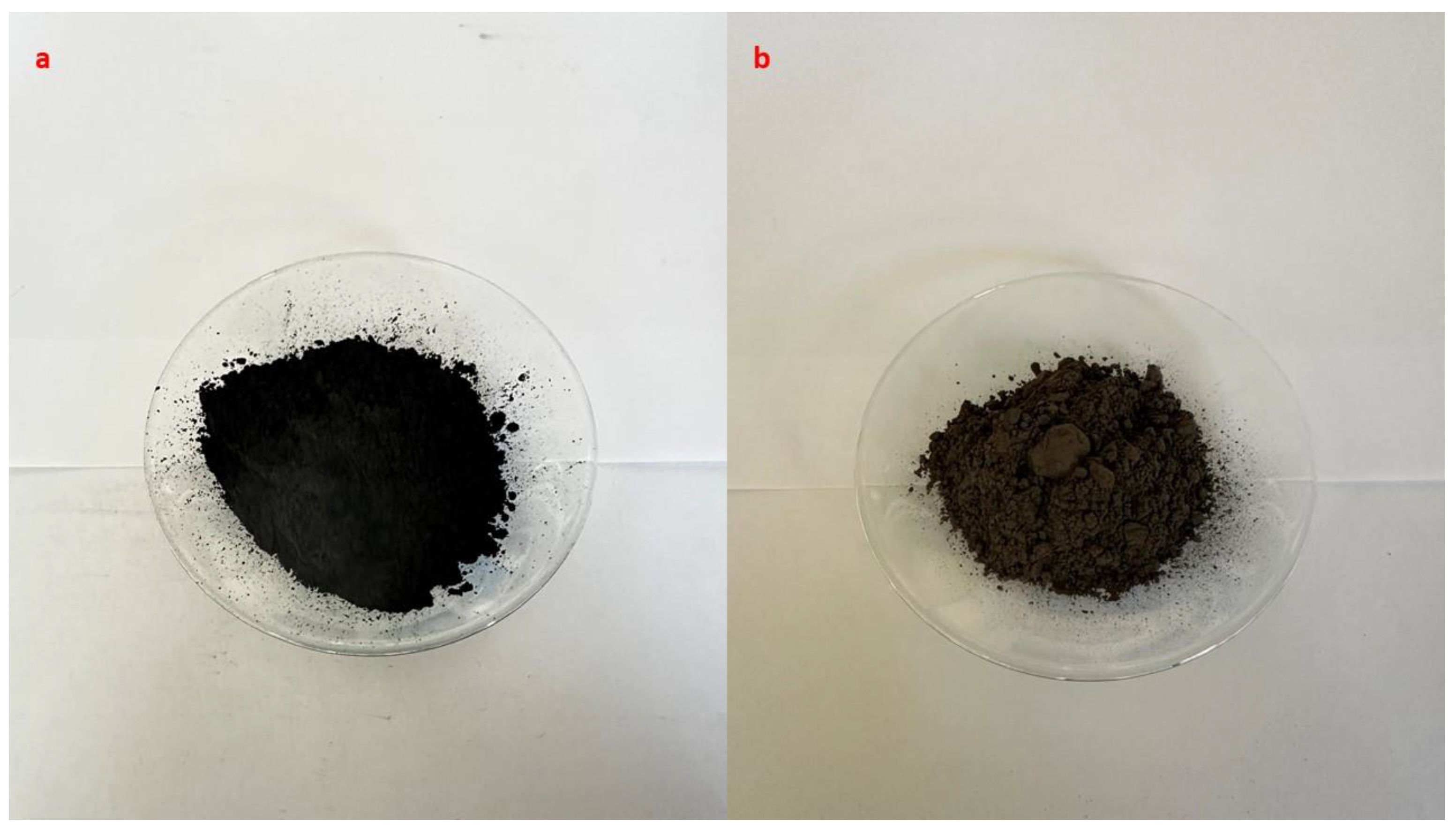
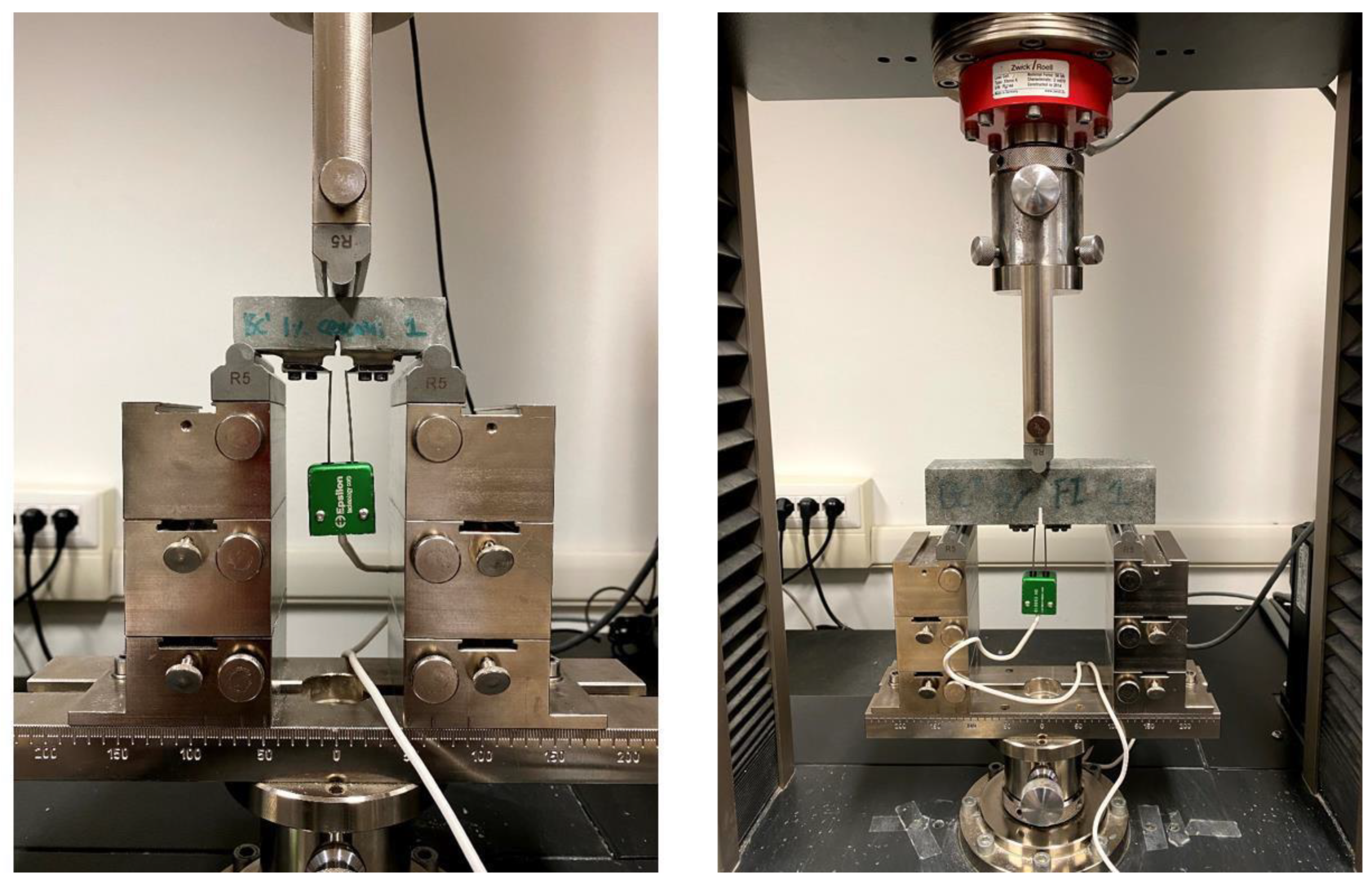


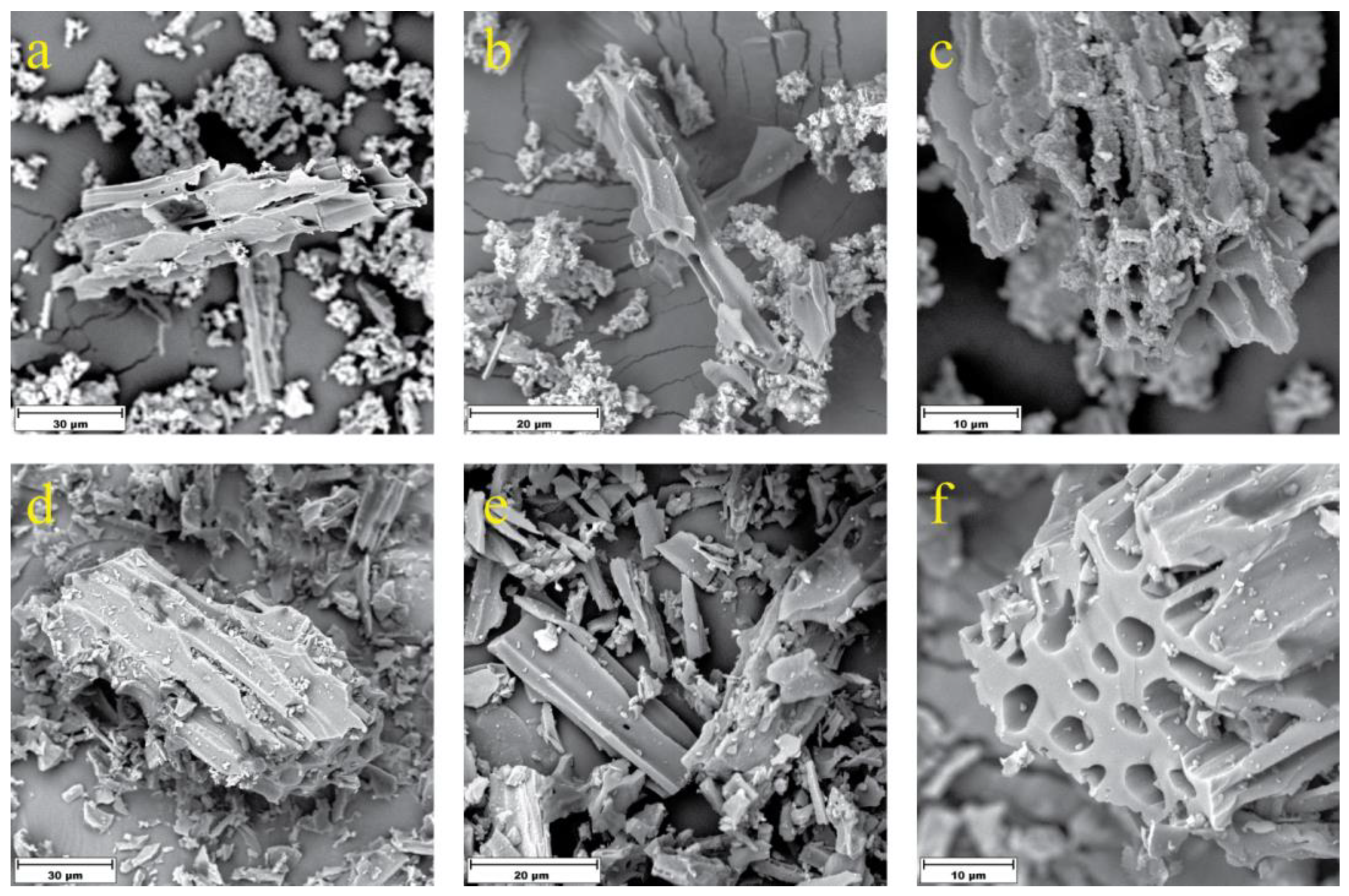
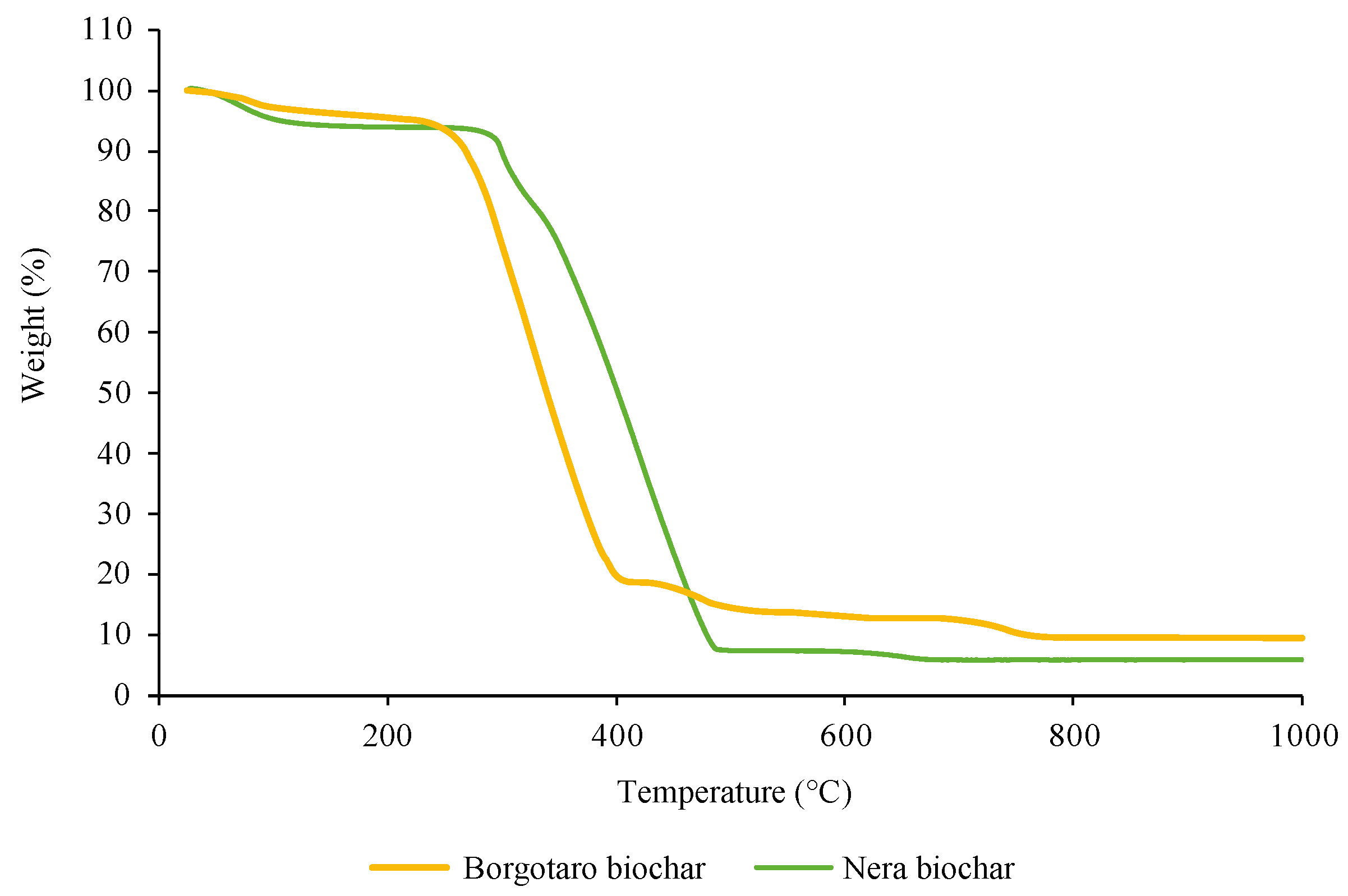
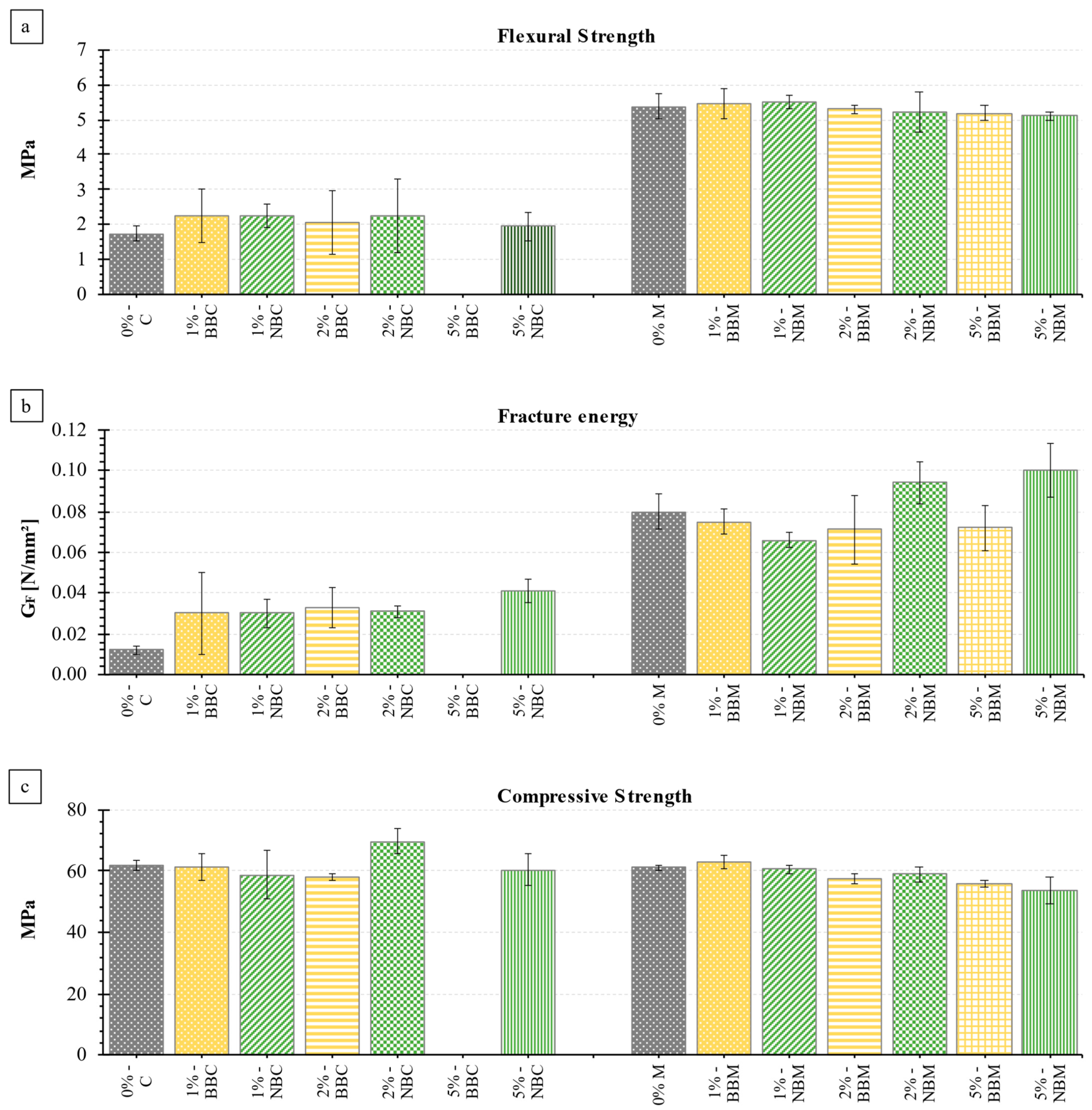
| Mix ID | Description | Cement [g] | Water [g] | SP [%] * | Sand [g] | Biochar [g] |
|---|---|---|---|---|---|---|
| 0% C | Plain Cement-paste | 460 | 161 | 1 | - | 0 |
| 1%-BBC | Cement-paste with 1% of Borgotaro biochar as filler | 460 | 161 | 1 | - | 4.6 |
| 1%-NBC | Cement-paste with 1% of Nera biochar as filler | 460 | 161 | 1 | - | 4.6 |
| 2%-BBC | Cement-paste with 2% of Borgotaro biochar as filler | 460 | 161 | 1 | - | 9.2 |
| 2%-NBC | Cement-paste with 2% of Nera biochar as filler | 460 | 161 | 1 | - | 9.2 |
| 5%-BBC | Cement-paste with 5% of Borgotaro biochar as filler | 460 | 161 | 1 | - | 23 |
| 5%-NBC | Cement-paste with 5% of Nera biochar as filler | 460 | 161 | 1 | - | 23 |
| 0% M | Plain Mortar | 450 | 225 | - | 1350 | 0 |
| 1%-BBM | Mortar with 1% of Borgotaro biochar as filler | 450 | 225 | - | 1350 | 4.5 |
| 1%-NBM | Mortar with 1% of Nera biochar as filler | 450 | 225 | - | 1350 | 4.5 |
| 2%-BBM | Mortar with 2% of Borgotaro biochar as filler | 450 | 225 | - | 1350 | 9.18 |
| 2%-NBM | Mortar with 2% of Nera biochar as filler | 450 | 225 | - | 1350 | 9.18 |
| 5%-BBM | Mortar with 5% of Borgotaro biochar as filler | 450 | 225 | - | 1350 | 22.5 |
| 5%-NBM | Mortar with 5% of Nera biochar as filler | 450 | 225 | - | 1350 | 22.5 |
| Biochar | Water Absorption [g/gdbc] * | Particle Size (D × 50) [µm] | Surface Area [m2/g] | Average Pore Size [nm] |
|---|---|---|---|---|
| Borgotaro | 2.17 | 8.2 | 30 | 3.27 |
| Nera | 0.97 | 7.9 | 25.27 | 1.22 |
Disclaimer/Publisher’s Note: The statements, opinions and data contained in all publications are solely those of the individual author(s) and contributor(s) and not of MDPI and/or the editor(s). MDPI and/or the editor(s) disclaim responsibility for any injury to people or property resulting from any ideas, methods, instructions or products referred to in the content. |
© 2023 by the authors. Licensee MDPI, Basel, Switzerland. This article is an open access article distributed under the terms and conditions of the Creative Commons Attribution (CC BY) license (https://creativecommons.org/licenses/by/4.0/).
Share and Cite
Suarez-Riera, D.; Falliano, D.; Carvajal, J.F.; Celi, A.C.B.; Ferro, G.A.; Tulliani, J.M.; Lavagna, L.; Restuccia, L. The Effect of Different Biochar on the Mechanical Properties of Cement-Pastes and Mortars. Buildings 2023, 13, 2900. https://doi.org/10.3390/buildings13122900
Suarez-Riera D, Falliano D, Carvajal JF, Celi ACB, Ferro GA, Tulliani JM, Lavagna L, Restuccia L. The Effect of Different Biochar on the Mechanical Properties of Cement-Pastes and Mortars. Buildings. 2023; 13(12):2900. https://doi.org/10.3390/buildings13122900
Chicago/Turabian StyleSuarez-Riera, Daniel, Devid Falliano, Juan Felipe Carvajal, Adriana Carolina Bravo Celi, Giuseppe Andrea Ferro, Jean Marc Tulliani, Luca Lavagna, and Luciana Restuccia. 2023. "The Effect of Different Biochar on the Mechanical Properties of Cement-Pastes and Mortars" Buildings 13, no. 12: 2900. https://doi.org/10.3390/buildings13122900
APA StyleSuarez-Riera, D., Falliano, D., Carvajal, J. F., Celi, A. C. B., Ferro, G. A., Tulliani, J. M., Lavagna, L., & Restuccia, L. (2023). The Effect of Different Biochar on the Mechanical Properties of Cement-Pastes and Mortars. Buildings, 13(12), 2900. https://doi.org/10.3390/buildings13122900









